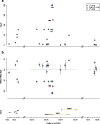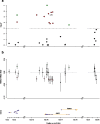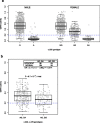Genetic determinants of glucose-6-phosphate dehydrogenase activity in Kenya
- PMID: 25201310
- PMCID: PMC4236593
- DOI: 10.1186/s12881-014-0093-6
Genetic determinants of glucose-6-phosphate dehydrogenase activity in Kenya
Abstract
Background: The relationship between glucose-6-phosphate dehydrogenase (G6PD) deficiency and clinical phenomena such as primaquine-sensitivity and protection from severe malaria remains poorly defined, with past association studies yielding inconsistent and conflicting results. One possibility is that examination of a single genetic variant might underestimate the presence of true effects in the presence of unrecognized functional allelic diversity.
Methods: We systematically examined this possibility in Kenya, conducting a fine-mapping association study of erythrocyte G6PD activity in 1828 Kenyan children across 30 polymorphisms at or around the G6PD locus.
Results: We demonstrate a strong functional role for c.202G>A (rs1050828), which accounts for the majority of variance in enzyme activity observed (P=1.5×10⁻²⁰⁰, additive model). Additionally, we identify other common variants that exert smaller, intercorrelated effects independent of c.202G>A, and haplotype analyses suggest that each variant tags one of two haplotype motifs that are opposite in sequence identity and effect direction. We posit that these effects are of biological and possible clinical significance, specifically noting that c.376A>G (rs1050829) augments 202AG heterozygote risk for deficiency trait by two-fold (OR = 2.11 [1.12 - 3.84], P=0.014).
Conclusions: Our results suggest that c.202G>A is responsible for the majority of the observed prevalence of G6PD deficiency trait in Kenya, but also identify a novel role for c.376A>G as a genetic modifier which marks a common haplotype that augments the risk conferred to 202AG heterozygotes, suggesting that variation at both loci merits consideration in genetic association studies probing G6PD deficiency-associated clinical phenotypes.
Figures




References
-
- Clark T, Fry A, Auburn S, Campino S, Diakite M, Green A, Richardson A, Teo Y, Small K, Wilson J, Jallow M, Sisay-Joof F, Pinder M, Sabeti P, Kwiatkowski D, Rockett K. Allelic heterogeneity of G6PD deficiency in West Africa and severe malaria susceptibility. Eur J Hum Genet. 2009;17(8):1080–1085. doi: 10.1038/ejhg.2009.8. - DOI - PMC - PubMed
-
- Jallow M, Teo Y, Small K, Rockett K, Deloukas P, Clark T, Kivinen K, Bojang K, Conway D, Pinder M, Sirugo G, Sisay-Joof F, Usen S, Auburn S, Bumpstead S, Campino S, Coffey A, Dunham A, Fry A, Green A, Gwilliam R, Hunt S, Inouye M, Jeffreys A, Mendy A, Palotie A, Potter S, Ragoussis J, Rogers J, Rowlands K. et al.Genome-wide and fine-resolution association analysis of malaria in West Africa. Nat Genet. 2009;41(6):657–665. doi: 10.1038/ng.388. - DOI - PMC - PubMed
Publication types
MeSH terms
Substances
Grants and funding
LinkOut - more resources
Full Text Sources
Other Literature Sources
Medical
Miscellaneous

